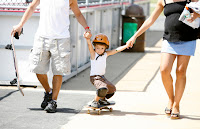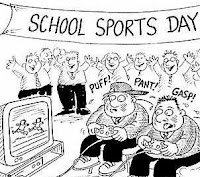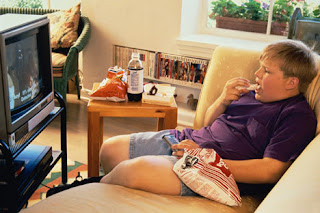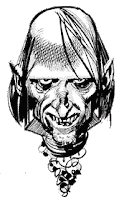
Team sports can help a child gain self-esteem, coordination, and general fitness, and help them learn how to work with other kids and adults. But some kids aren't natural athletes and they may tell you - directly or indirectly - that they just don't like sports. What then?
Why Some Kids Don't Like TeamsEvery child doesn't have to join a team, and with enough other activities, kids can be fit without them. But it's a good idea to find out why your child isn't interested. You might be able to help solve any deeper concerns your child might be having, or steer your child toward something else. Talk with your child and let him or her know that you'd like to work on a solution together. That solution might mean making changes and sticking with the team sport or finding a new activity to try.
Here are some reasons why sports might be a turnoff for a child:Still Developing Basic SkillsThough many sports programs are available for preschoolers, it's not until about age 6 or 7 that most kids have the physical skills, the attention span, and the ability to grasp the rules needed to play organized sports. If your child hasn't had much practice in a specific sport, it may take a while for him or her to be expected to reliably perform necessary skills such as kicking a soccer ball on the run or hitting a baseball thrown from the pitcher's mound. Trying and failing, especially in a game situation, might frustrate your child and make him or her nervous.
What You Can Do. Practice with your child at home. Whether you're shooting baskets, playing catch, or going for a jog together, you're giving your child an opportunity to build his or her skills and fitness in a safe environment. Your child can freely try - and risk failing - new things without the self-consciousness of being around his or her peers. And you're also getting a good dose of quality together time.
Coach or League Is Too CompetitiveA kid who's already a reluctant athlete might feel extra-nervous when the coach barks out orders or the league focuses heavily on winning.
What You Can Do. Investigate sports programs before signing your child up for one. Talk with coaches and other parents about the philosophy. Some athletic associations, like the YMCA, have noncompetitive leagues. In some programs, they don't even keep score.
Keep in mind that as kids get older, they can handle more competitive aspects such as keeping score and keeping track of wins and losses for the season. Some kids may be motivated by competitive play, but the average child may not be ready for the increased pressure until he or she is 11 or 12 years old. Remember that even in more competitive leagues, the atmosphere should remain positive and supportive for all the participants.
Stage FrightIf your child isn't a natural athlete, or is a little shy, he or she might be uncomfortable with the pressure of being on a team. More self-conscious kids also might worry about letting their parents, coaches, or teammates down. This is especially true if the child is still working on basic skills and if the league is very competitive.
What You Can Do. Keep your expectations realistic - most kids don't become Olympic medalists or get sports scholarships. Let your child know the goal is to be fit and have fun. If the coach or league doesn't agree, it's probably time to look for something new.
Still Shopping for a SportSome kids haven't found the right sport. Maybe your child didn't have the hand-eye coordination for baseball, but he or she has the drive and the build to be a swimmer, a runner, or a cyclist. The idea of an individual sport also can be more appealing to some kids who like to go it alone.
What You Can Do. Be open to your child's interests in other sports or activities. That can be tough if, for instance, you just loved basketball and wanted to continue the legacy. But by exploring other options, you give your child a chance to get invested in something he or she truly enjoys.
Other BarriersDifferent kids mature at different rates, so it's common for there to be a wide range of heights, weights, and athletic abilities among kids of the same age group. So if your child is much bigger or smaller than other kids of the same age - or less coordinated or not as strong - he or she may feel self-conscious and uncomfortable competing with them. Your child also may be afraid of getting injured, or worried that he or she can't keep up. A child who is overweight might be reluctant to participate in a sport, for example, while a child who has asthma might feel more comfortable with sports that require short outputs of energy, like baseball, football, gymnastics, downhill skiing, and shorter track and field events.
What You Can Do. Give some honest thought to your child's strengths, abilities, and temperament, and find an activity that might be a good match. Some kids are afraid of the ball, so they don't like softball or volleyball, but may enjoy an activity like running. If your child is overweight, he or she might lack the endurance to run, but might enjoy a sport like swimming. Your child may be too short for the basketball team, but may enjoy gymnastics or wrestling.
Keep in mind that some kids just prefer sports that focus on individual performance rather than teamwork. Remember that the goal is to prevent your child from feeling frustrated, wanting to quit, and being turned off from sports and physical activity altogether.
With good communication, you may be able to address your child's concerns. Other issues may naturally fade as your child grows. If you can understand what your child is going through and provide a supportive environment, you can help your child succeed in whatever activity he or she chooses.
Ways to Stay Fit Outside of Team SportsEven kids who once said they hated sports might learn to like team sports as their skills improve, or if they find the right sport or a league with the right level of intensity. But even if team sports never thrill your child, there's plenty a kid can do to get the recommended 60 minutes or more of physical activity each day.
Free play can be very important for a child who doesn't play a team sport. What's free play? It's the activity kids get when they're left to their own devices, like shooting hoops, riding bikes, playing whiffleball, playing tag, jumping rope, or dancing.
Outside of the most common team sports, your child might want to try individual sports or other organized activities that can boost his or her fitness. Here are some ideas:
skateboarding
cycling
inline skating
martial arts
swimming
horseback riding
dance classes
cheerleading
hiking
golf
tennis
fencing
gymnastics
yoga and other fitness classes
Ultimate Frisbee
running
Supporting Your Kid's ChoicesEven if the going's tough, work with your child to find something active that he or she likes. Try to remain open-minded. Maybe your child is interested in an activity that is not offered at his or her school. If your daughter wants to try flag football or ice hockey, for example, help her find a local league or talk to school officials about starting up a new team.
You'll need to be patient if your child has difficulty choosing and sticking to an activity. It often takes several tries before a child finds one that feels like the right fit. But when something clicks, you'll be glad you invested the time and effort. For your child, it's one big step toward developing active habits that can last a lifetime.
Original Source: kidshealth.org
 Wolverine Annual #1
Wolverine Annual #1




































